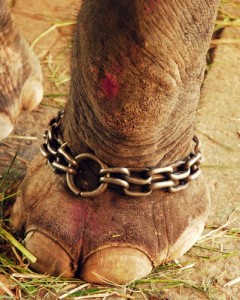It was recently reported that a Russian circus bear killed a circus manager, 25-year-old Dmitry Potapov, and critically injured another circus worker who tried to rescue the manager. Though we may not hear about every incident involving a circus animal who turns on its captors, there are plenty of eye-raising instances, such as the one below. Tyke, a 20-year-old African elephant went on a rampage during a performance in Hawaii in August of 1994, killing her trainer and severely injuring her groomer.
(Warning: the following footage contains graphic images)
The Humane Society of the United States keeps a detailed list of circus incidents involving animals, from 1978 to the present. To read this lengthy list is to realize how common these attacks are, and how using (and in most instances, abusing) animals in circus and zoo performances is arcane and unethical. BornFreeUSA.org, an animal protection initiative, lists 10 fast facts about animals in the circus:
- Every major circus that uses animals has been cited for violating the minimal standards of care set forth in the United States Animal Welfare Act (AWA).
- Animals in circuses spend about 11 months of the year traveling.
- During travel, animals may be caged or chained for long distances and hours, forced to stand in their own waste, in extreme temperatures.
- Standard circus industry training tools used on animals include bullhooks, whips, clubs, and electric prods.
- Animals born in circus “conservation” breeding programs have never been released into the wild.
- From 1994 to 2005, at least 31 elephants have died premature deaths in the circus. Other circus animals who have died in an untimely manner include horses and lions.
- Captive elephant and captive feline attacks on humans in the U.S. have resulted in hundreds of injuries, many resulting in death.
- In the wild, elephants live in large, sociable herds and walk up to 25 miles every day. Most other wild animals found in circus settings, including lions and tigers, are also constantly on the move in their native habitats. In the circus, animals spend most of their time in cages or chains.
- Officials from the U.S. Department of Agriculture (which enforces the AWA) have repeatedly ignored obvious physical trauma to animals, eyewitness accounts of mistreatment, and sworn testimony from former circus employees who report abuse of elephants.
- Circuses that feature only human performers are gaining in popularity and provide dazzling, humane, and truly family-friendly entertainment.
In fact, circuses that provide human-only performances and entertainment are not only becoming more popular, but in some towns, they are the only choice. Earlier this year, Michigan State University students pushed to ban the Royal Hanneford Circus, citing allegations of animal abuse. In Queensland, Australia, a city council ruled that circuses involving animal performances are banned as of June of this year. And in Bolivia, both wild and domestic animals have been banned from circus performances within the country. Is this a sign of the times? Have animal circuses become a relic of the past?

